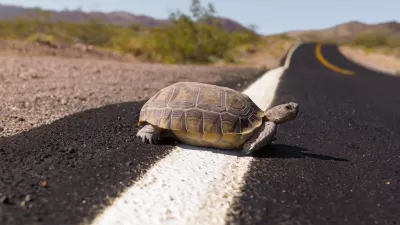The ‘Room to Roam Act’ would require cities and counties to consider local habitats and the impact of development on wildlife corridors and connectivity.

A proposed California bill dubbed the “Room to Roam Act” would require general plans to consider “fish, wildlife, and habitat connectivity,” signaling a shift toward more conservation-minded development.
According to a blog post on the Nossaman LLP website, Assembly Bill 1889 would require cities and counties to make the necessary updates to their general plans by January 1, 2026. “Section 1 of the Room to Roam Act would require local jurisdictions to ‘consider and implement measures to avoid, minimize, and mitigate impacts to fish, wildlife, and habitat connectivity from existing and planned land uses within their jurisdictions.’”
The post adds, “The updated conservation element must: identify and analyze connectivity, permeability, and natural landscape areas within the jurisdiction; identify and analyze wildlife passage features; consider impacts of wildlife barriers caused by development and avoid, minimize and mitigate these impacts; and analyze and consider options to remediate barriers to wildlife connectivity and restore degraded habitat and open landscape.”
The bill could help cities balance conservation, housing, and climate resilience, but may also lengthen the development approval process.
FULL STORY: California’s “Room to Roam Act:” Factoring Wildlife Connectivity Into Land Use Planning

Study: Maui’s Plan to Convert Vacation Rentals to Long-Term Housing Could Cause Nearly $1 Billion Economic Loss
The plan would reduce visitor accommodation by 25,% resulting in 1,900 jobs lost.

North Texas Transit Leaders Tout Benefits of TOD for Growing Region
At a summit focused on transit-oriented development, policymakers discussed how North Texas’ expanded light rail system can serve as a tool for economic growth.

Why Should We Subsidize Public Transportation?
Many public transit agencies face financial stress due to rising costs, declining fare revenue, and declining subsidies. Transit advocates must provide a strong business case for increasing public transit funding.

How to Make US Trains Faster
Changes to boarding platforms and a switch to electric trains could improve U.S. passenger rail service without the added cost of high-speed rail.

Columbia’s Revitalized ‘Loop’ Is a Hub for Local Entrepreneurs
A focus on small businesses is helping a commercial corridor in Columbia, Missouri thrive.

Invasive Insect Threatens Minnesota’s Ash Forests
The Emerald Ash Borer is a rapidly spreading invasive pest threatening Minnesota’s ash trees, and homeowners are encouraged to plant diverse replacement species, avoid moving ash firewood, and monitor for signs of infestation.
Urban Design for Planners 1: Software Tools
This six-course series explores essential urban design concepts using open source software and equips planners with the tools they need to participate fully in the urban design process.
Planning for Universal Design
Learn the tools for implementing Universal Design in planning regulations.
Ascent Environmental
Borough of Carlisle
Institute for Housing and Urban Development Studies (IHS)
City of Grandview
Harvard GSD Executive Education
Toledo-Lucas County Plan Commissions
Salt Lake City
NYU Wagner Graduate School of Public Service





























